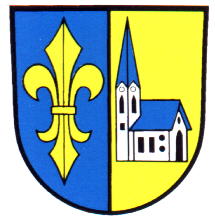Eriskirch: Difference between revisions
Knorrepoes (talk | contribs) m (Text replacement - "/Arms of " to "/Arms (crest) of ") |
Knorrepoes (talk | contribs) m (Text replacement - "{{media}}" to " {{de1}} {{media1}}") |
||
| Line 25: | Line 25: | ||
The arms show in the right half a fleur-de-lis. The symbol was derived from the old village sign, used on border stones. The use of a fleur-de-lis was first proposed in 1936, but no arms were granted at the time. The church (Kirche) in the left half is a canting symbol. | The arms show in the right half a fleur-de-lis. The symbol was derived from the old village sign, used on border stones. The use of a fleur-de-lis was first proposed in 1936, but no arms were granted at the time. The church (Kirche) in the left half is a canting symbol. | ||
{{ | |||
{{de1}} | |||
{{media1}} | |||
[[Civic Heraldry Literature - Germany|'''Literature''']]: Bardua, 1987 | [[Civic Heraldry Literature - Germany|'''Literature''']]: Bardua, 1987 | ||
Revision as of 11:44, 26 December 2022
This page is part of the German heraldry portal Deutsche Wappensammlung |
Heraldry of the World |
|
German heraldry:
|
Selected collector's items from Germany:
|
ERISKIRCH
State : Baden-Württemberg
District (Kreis) : Bodenseekreis (until 1973 Tettnang)
Additions : 1937 Mariabrunn
| German |
Gespalten von Blau und Gold, vorne eine goldene Lilie (Iris), hinten eine blau bedachte silberne Kirche in perspektivischer Sicht mit rechtsstehendem, ins Langhaus integriertem Glockenturm mit spitzem Rhombendach und schwarzem Portal an der linken Stirnseite. |
| English | No blazon/translation known. Please click here to send your (heraldic !) blazon or translation |
Origin/meaning
The arms were granted on June 30, 1952.
The arms show in the right half a fleur-de-lis. The symbol was derived from the old village sign, used on border stones. The use of a fleur-de-lis was first proposed in 1936, but no arms were granted at the time. The church (Kirche) in the left half is a canting symbol.
Literature: Bardua, 1987


